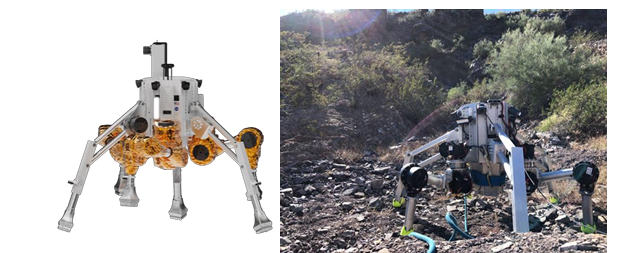There are many obstacles in the way of exploring challenging environments (e.g., the lunar surface's permanently shadowed regions (PSRs)). The rocky terrain, steep inclines, and slick regolith that are typical in these places present challenges for traditional wheeled rovers. For these explorations to be effective, a vehicle needs to have low power, be extremely efficient, and able to navigate these intricate settings without the need for human assistance. Moreover, considering the high expense of transportation to these surfaces, these vehicles need to be able to carry heavy loads and maintain a high level of reliability over lengthy periods of time. Improving our comprehension of these unreachable areas requires tackling these obstacles.
Researchers at the Arizona State University have developed a hexapedal walking robot designed specifically to traverse challenging geological environments on Earth and on other planets. The robot is designed to carry advanced scientific payloads up and down steep terrain. This robot can perform intricate climbing and descending tasks because of its unique walking pattern and leg arrangement, which also improve stability and require fewer actuators. Six legs make up the robot's locomotion platform; three of the legs have three degrees of freedom (3-DOF) and the remaining three legs are positioned in an alternating pattern around the robot's center to give them one degree of freedom (1-DOF).
This innovative configuration ensures the robot maintains a stable position at all times, typically supported by at least a tripod configuration. Because of its stability, burst power is not necessary to maintain balance during locomotion, allowing for precise control over power use. In comparison to traditional hexapedal robots with six 3-DOF legs, this technology is more efficient and mechanically simpler because it requires fewer actuators. This concept works well for long-range, low-power exploration of rough environments like craters and mountains as the robot is capable of climbing and descent of complex, rocky and slippery regolith terrain. Related publication: CHARLOTTE Final Technical Paper

Figure: CAD model render (left), Robot during environmental testing (right)
Potential Applications:
- Lunar Exploration
- Planetary Missions
- Terrestrial Uses (e.g., oceanic, mining, and mountain explorations)
Benefits and Advantages:
- Improved Stability
- Reduced Actuator Count
- Complex Maneuverability (such as omnidirectional translation, turning in place, and 6-DOF orientation control when standing)
- Efficiency – low power, long range